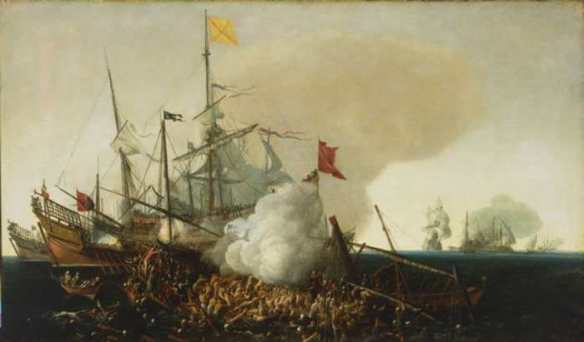Cornelis Hendriksz Vroom, Spanish Men-of-War Engaging Barbary Corsairs, 1615
The “corsairs” were the navies and cruising warships of several small Muslim principalities-Algiers, Tripoli, and Tunis- in the Maghreb. They were so called in the West from their traditional form of naval warfare, the “corso.” This practice was directly comparable to privateer war as practiced by Europeans, wherein public wars were carried out by private naval interests on license from the monarch. These North African cities and their hinterlands were termini of the major overland gold, salt, leather, and slave trades, whose great caravans crossed the Sahara out of West Africa. For centuries corsair navies harassed and plundered commerce in the western Mediterranean, as did the navies and private warships of virtually every other trading power across that nearly enclosed sea. The Regencies also joined in Ottoman naval wars against Venice, Genoa, and Spain-most notably before and at Lepanto in 1571. All those Christian states were rivals and competitors with the small African emirates that controlled the Mediterranean coast of North Africa. Barbary galleys and galliots raided widely along the coasts of western and southern Europe, patrolling for Christian slaves. Their main areas of attack were coastal Iberia, Sicily, and Italy, but some raids took them as far as the Atlantic coasts of France, England, and Ireland. Raids attenuated from the 16th century as European naval power, and the fighting power of ships of sail, increased relative to the galley navies of Africa. Treated as pirates in European propaganda, the corsairs were bitterly opposed by Spanish monarchs during the late medieval Reconquista. In the early 16th century they loosened-though they did not formally break-longstanding ties to the declining naval power of the Sublime Porte. That shift encouraged Spain to become de facto protector of the corsair states against efforts by the Ottomans to reassert full control. As a result, the corsairs sometimes allied with Spanish kings against shared enemies during the 16th-17th centuries. From 1610-1633 the corsairs captured over 2,500 French ships, until Cardinal Armand Richelieu and Louis XIII sent punitive expeditions against them. Other European states acted against the corsairs out of religious or commercial antagonism. For example, in the 1650s Oliver Cromwell sent an English expedition against the corsairs, led by Robert Blake. This type of one-off action was always very difficult, because Barbary cities were well fortified and occupied a lee shore that was highly dangerous for attacking warships.
Louis XIV acted against the corsairs principally for commercial reasons, ordering a naval raid in 1664 against Djidjelli on the Algiers coast. It failed. In the 1680s he sent more raiding fleets. Algiers struck back at French ships and trade. Louis retaliated by sending Admiral Duquesne with a fleet that included a number of early bomb ketches, or “galiotes a bomb,” each mounting two mortars. This fleet bombarded corsair safe harbors in the Aegean and then attacked the main corsair bases in North Africa. Duquesne bombarded Algiers in August-September 1682. He returned the following summer to bombard the city once again. These actions badly damaged the port and city and inflicted high civilian casualties. Facing another bombardment in 1684, Algiers quickly asked for terms. The next year, the French galiotes a bomb and other warships bombarded Tripoli and Tunis, which accepted terms that included paying a large indemnity and releasing many Christian slaves. England (later Great Britain) developed a unique relationship with the corsairs only after the radical Christian prejudices of Cromwell and the Restoration alike were set aside in favor of more rational calculations of commercial and even “national” interests. From the later 17th century through the early 19th century, it was English policy to hammer the corsairs on occasion, enough to make them wary, but also to deal with them fairly in terms of trade so that they tended to leave British ships unmolested and preyed instead on the Mediterranean shipping and trade of England’s enemies.
Suggested Reading: Peter Earle, Corsairs of Malta and Barbary (1970).
